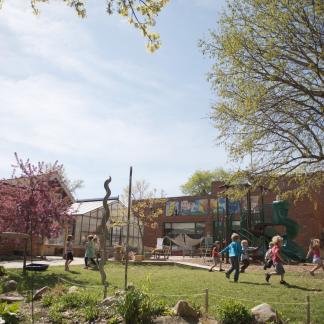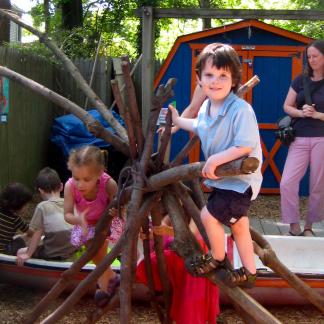Would you build a house without a blueprint? Travel without a map? Make chocolate souffle without a recipe? I didn’t think so! In the same way, you wouldn’t want to create a schoolyard without a plan!
This article shares the journey of a public school playground’s transformation into a beautiful space where children experience moments of wonder and learning in nature every day. From dreaming big with our students to engaging individuals and organizations beyond the school community, what we learned at the Peter Woodbury School in Bedford, New Hampshire may help you to build an outdoor learning area at your school, as well!
Step One: Dream Big!
The story of our Community School Yard begins ten years ago, after my colleagues and I read Richard Louv’s book, Last Child in the Woods, and decided we wanted to change the way we taught. The book felt like a call to action. We were determined do something, but what exactly? And how?
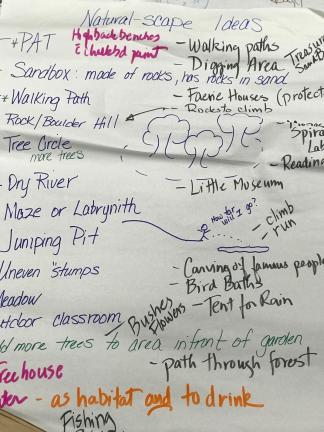
Like many public school districts, ours has a policy that district dollars are for student learning inside the classroom. The only outdoor spaces that receive district funding are sports fields. Sigh. We had a mile-long list of dreams, no funding, and not a clue as to how to make our outdoor learning space come to life. We realized that we needed a plan and that we needed some help.
Step Two: Utilize Community Resources
Months later, on a hot August day, I arrived on the doorstep of Susanne Smith Meyer, my arms loaded with kids’ drawings, lists, and clay models. At the time, Susanne was the Department Head for the Landscape Design Programs at NHTI-Concord’s Community College. As a landscape architect, Susanne was instantly enthused about the potential of using our idea for an outdoor learning space as a class project for her landscape design students. Even though the scope was beyond what they would normally tackle, this project was an opportunity to challenge her students and deliver a plan that would appeal to our school community and beyond.
Susanne and her students were the missing piece, and once we had them on board, we began to see our vision come to life. They surveyed the space and used our drawings and wishlist as they tried to fit our ideas into that space. Each student created a design concept for our outdoor learning space and presented it to a panel of educators and administrators. The designs were discussed and tweaked until a final plan emerged, combining all of the best ideas.
Though they were a fundamental part of our story, Susanne and her students weren’t the only ones we leaned on during this process. We reached out to environmental educator and Antioch University faculty member, David Sobel, and he helped us see that our audience was greater than just our school community. We had been overwhelmed at the beginning of this project, but came to realize that we were not alone and that there were people out there that wanted to help. Community resources, grants, and investors are out there -- if you look for them!
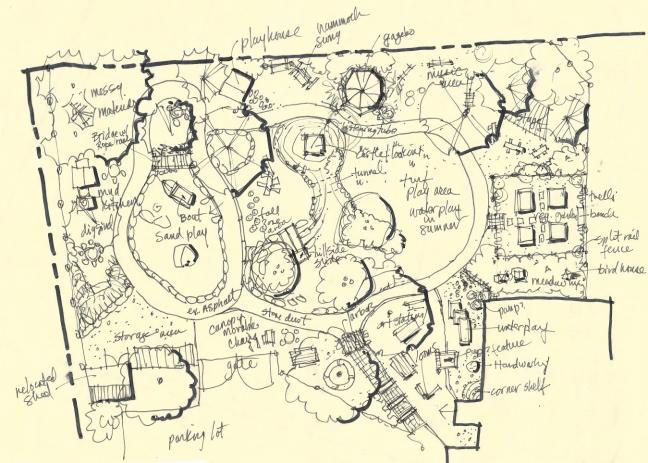
Step 3: Tell Your Story
With our final plan in hand, it was time to share our vision and find support for turning it into reality. A picture truly paints a thousand words, so we were grateful to have a beautiful one, thanks to Susanne. Our plan was put in the newspaper, taken to community organizations, shared with parents, banks, and grantmakers. Our pot of funding grew from zero (in the economic crisis of 2008) to thousands, as people began to understand and share our hopes for the space.
Share your vision in any way you can! We gathered a letter of support from our superintendent and drawings from students, along with other documents of support, and shared them with potential funders. We made a video that showed the existing condition of our schoolyard and what we imagined it could be. We compiled research and photos and made brochures. Our students contributed their lemonade stand sales and asked for donations at their birthday parties, in lieu of presents. It was truly a community effort. We thanked everyone who helped us get closer to our goal and shared our story far and wide.
In all, our plan raised $150k in grants and financial and in-kind donations. It takes time and a lot of effort, but it is possible. Be creative. Recycle. Ask for help. Always return to your plan.
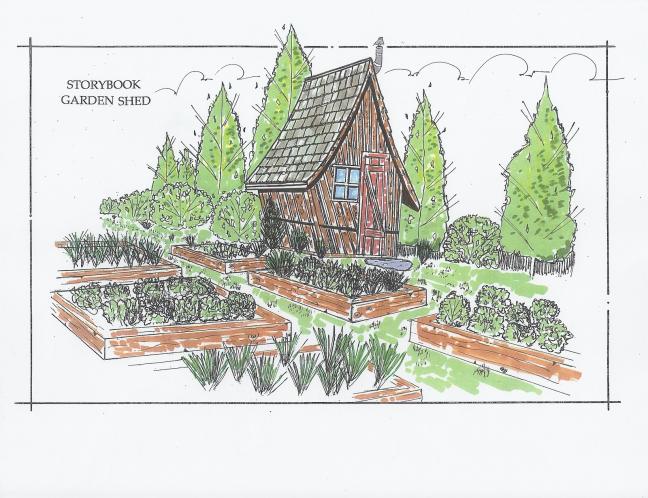
Step 4: Build It
It was amazing to see our plan come to life. Everyone chipped in! We had families, local businesses, students, scouts, Master Gardeners, and other community members help us install different elements of the outdoor classroom. We had donations of boulders, tree cookies, plants, wood, labor, lumber, etc. In the end, we had sore bodies, slight injuries, sunburns, tears, and smiles of absolute delight.
The excitement of the plan and build phase eventually faded as we were faced with challenges of sustainability. Our beautiful plantings grew and regularly need pruning, our gardens need weeding, and the wooden raised-beds we built ten years ago now need replacing. But these challenges are not insurmountable.Through ongoing fundraising, after-school and summer gardening clubs, and with parent and community support, we have been able to weather the seasons. Our school yard is not static, but a reflection of the times and an important beacon for the future.
Now our journey to build our Community School Yard is a part of our school’s history. The plan we created hangs in the hallway at our school as a reminder of a dream that became a reality. And while the original children are now graduates of high school and college, our plan is a reminder to new parents of the seed that was planted. It shows how our learning has grown from inside out.
Additional Resources:
Danks, Sharon Gamson. Asphalt to Ecosystem. 2010
Sobel, David. Childhood and Nature: Design Principles for Educators. 2008
Moore, Robin C., & Wong, Herbert. H. Natural Learning: The Life History of an Environmental Schoolyard. 1997
Naturally Rooted, LLC: Designing Natural Landscapes for Nature’s Children
About the Author
Mindy Beltramo is an educator at Peter Woodbury Elementary School. This summer, she is embarking on a new adventure opening The Dewey School, a nature-based preschool at The Canterbury Shaker Village in New Hampshire. She knows none of it would have been possible without a plan, which she carries with her to help her tell her story.
Mindy wishes to thank Susanne Smith Meyer, a licensed landscape architect and the principal architect at Naturally Rooted, LLC, a landscape design company that designs imaginative, creative, and sustainable nature-based learning and play environments, for her critical help with the Community School Yard and this article.
Visit Peter Woodbury School's Community School Yard during our 2019 Natural Start Conference! Sign up for the Boston Area Field Trip on Saturday, August 3 to hear from Mindy and Susanne about how they brought their plan to life.



